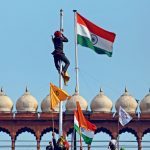Margin of Error
How safe are you when you take a monsoon flight?
 Akshay Sawai
Akshay Sawai
 Akshay Sawai
|
29 Aug, 2012
Akshay Sawai
|
29 Aug, 2012
/wp-content/uploads/2015/11/monsoon-flying.jpg)
How safe are you when you take a monsoon flight?
The phrases ‘miraculous escape’ and ‘near miss’ are common in aviation headlines in India. They seem to amuse and annoy Captain Dhananjay Gole of Jet Airways in equal measure. We are having coffee at a Gloria Jean’s outlet in Oberoi Mall, North Mumbai, and when Captain Gole says “miraculous escape” and “near miss”, he says it with sarcastic emphasis. The media, he feels, often exaggerates things.
Captain Gole is in his 36th year of flying. He was in the Indian Air Force for 15 years before switching to commercial aviation. We are discussing the subject of flying during the monsoons. There is something foreboding about grey skies that worries even hardened travellers. India’s aviation governing body, the DGCA (Directorate General of Civil Aviation), acknowledges the perils of the monsoons too. ‘Weather related phenomenon can pose a serious hazard to the safety of operations,’ it says in a 2007 circular titled ‘Monsoon Operations’. Pilots agree that navigating a metal whale full of people through clouds, gusts of wind and gushes of rain is challenging. “You need to be on your balls,” one pilot says (perhaps he means ‘toes’).
But pilots also remind you that a modern aircraft is very sophisticated. It has a reliable weather radar that parents you every second of a flight. It has in the vicinity of 2,000 computers. It has back-ups and secondary back-ups and security systems that make it more disaster-proof every passing year.
“Rain, poor visibility, strong winds… the monsoon happens to be a combination of all these factors. Yes, to a certain extent, flying can be a little challenging in [this season],” Captain Gole says, gulping a whateverccino from a tall concave glass. He bears a mild resemblance to Steve Martin. He has just had a workout and is dressed simply—functional jeans and a faded polo shirt that must know the insides of the washing machine as well as its owner in the cockpit. He also carries an umbrella. At some level, it seems ridiculous for a pilot to need something as plebeian. Pilots operate mankind’s most improbable triumph over the elements: the aeroplane. They shouldn’t need umbrellas. At all times, even in rain, you feel there should be a halo of sunlight around them, so that they look like fireflies in downpours.
Gole plays down the task of pilots. “As compared to driving a car or riding a cycle, not many fly an aircraft. But if more people were to get into the cockpit… [they would see that flying is achievable]. What do you need to fly an aircraft? Motor skills and average intelligence, which you require to move any vehicle. It is just another means of transport. Yes, you are operating in the third dimension. So it requires a little more skill. But you need presence of mind even while driving or crossing a street with a lot of traffic.”
Gole understands, though, what lends flying its dark fascination. “Have you seen an aircraft crash?” he asks, even as brain-numbing music and announcements echo around the cavernous mall. Told that I hadn’t, he says, “I have seen an aircraft crash. It was during Air Force Day in Palam [Delhi]. It was probably 1989. A Mirage 2000 aircraft crashed. I have never, before and after, seen pindrop silence in such a large gathering of people. That is the kind of impact that aviation can have.”
In his innings in civil aviation, he has been lucky. He says he hasn’t gotten into situations where he has had to pull off the “miraculous escapes that seem to be happening in aviation every other day. Just a few days ago, there was a report of 150 passengers on an Air India flight having a ‘miraculous escape’. [But] it was a hydraulic failure. Hydraulic failure is just the failure of one system. There are procedures which tell you what to do if there’s a hydraulic failure—you do that and carry on.”
The captain or PIC (Pilot in Command), the boss of the flight, sits on the left seat in the cockpit. His understudy, the first officer or co-pilot, sits on the right. As per DGCA rules, both need a combined experience of 500 hours of flying time to operate a monsoon flight (not stringent enough, some feel). There is a captain with ten years of experience who has had some rough experiences during the rains. He meets us one morning at a karaoke bar in Andheri. He doesn’t want to be named, but like Gole, he is articulate and forthcoming with information. Speaking about landing during a deluge in Bhubaneswar, he sounds like a film director explaining a momentous scene to an actor. “You are so focused on the runway, [and] the wipers are going thak thak, thak thak, thak thak, thak thak,” Captain Anonymous says. “It was my first monsoon as a captain… and the first officer too was relatively inexperienced. He forgot to give me the landing lights. We somehow made it, but realised that it was tough. After an experience like that, your alertness and vigilance only stays high. And you also realise that every take-off and landing is different.”
This pilot was also in the cockpit when a plane landed in Mumbai a couple of days after the record downpour of 26 July 2005. He was a first officer then, and remembers his captain’s work as “a phenomenal landing with phenomenal grit and focus”. He says, “It was still raining and there were strong crosswinds. The captain executed a perfect crosswind landing, where the plane approaches the runway slightly sideways, facing the direction the wind is coming from, and gradually straightens. There couldn’t have been a better touchdown.”
But again, they had the support of advanced technology, which is why the world of aeroplanes always seems balanced on a precipice, with very real dangers on one side and advanced safety measures on the other. While landing continues to be a bitch, planes and airports are equipped with an ILS (Instrument Landing System). It guides an aircraft to its designated spot on the runway, called the 1,000 foot marker, so that there is enough space for the plane to come to a halt.
The task of landing at the right spot brings to mind the Mangalore crash, where an Air India Express flight from Dubai was found to have approached the runway from too high and touched down way too far along the strip. As a result, the Boeing 737-800 did not have enough yards to decelerate. The Mangalore International Airport was, in airline terminology, a ‘table-top’ field, hewn out of a hillock. As the plane overshot the runway, it caught fire and tipped over onto the slopes. Some believe that the accident was triggered by poor weather. But that wasn’t the case. Pilot error and concrete structures at the end of the runway were the main causes. The DGCA and Boeing representatives told a court of inquiry that the captain, Zlatko Glusica, did not heed warnings to abort landing.
The plane also came into high-speed contact with concrete structures near the runway. It was the fire thus caused—and not the landing per se—that led to 158 deaths, according to an inquiry report. An RTI application filed by Mint newspaper led the Airports Authority of India to disclose that Mangalore is one of six airports in India that remain dangerous because of concrete structures at the end of the runway (the other five are Patna, Agartala, Port Blair, Jammu and Calicut).
However advanced a plane, it has no defence yet against human error. The stormy night of 1 June 2009 gave us further evidence of how calamitous human error can be. In this case, there was also the added stress of mechanical complication. Four hours after taking off from Rio de Janeiro for Paris, Air France 447 plunged into the Atlantic Ocean, killing everyone on board, its last few minutes marked by confusion and horror. The crash perplexed people, till an exhaustive search for the flight data recorder and rigorous study provided answers.
“The Air France crash was a byproduct of one of aviation’s hazards, icing over of the speed probe systems, followed by mishandling of the aircraft,” says Gole, “The commander was not at the controls (he was resting, and came back to the cockpit once the problems began). You had two first officers sitting there. The aircraft got into very tricky conditions. All systems got iced over in a matter of seconds. And the third factor that came up later was that they didn’t have adequate training to handle a situation like that. Not the icing situation, but the fallout of the icing situation, which was ‘the stall’. What led to the crash was the stall. They did not know how to get out of the stall. That is where their lack of training showed. We always practise getting out of stall situations in the simulator. And we will never stop practising it.”
The Air France episode captures the challenge that pilots face. The machine they are handling is good enough for them to not do much beyond take-off and landing. But there is no saying when they will need to step in. You have to be alert all the time and simply cannot take chances, more so when flying through rough weather.
Says a captain, “The grooves of the tyres have to be visible. Both the wipers have to be functional. The anti-icing system has to work, thrust reversal has to work. In clear weather, there are times when [we fly with] one reversal not working, when the first officer’s wiper is not working. But not in the monsoons.” There also have to be extensive weather briefings. The DGCA has pointedly asked pilots to take meteorological briefings more seriously and not rely entirely on the weather radar. Airlines also carry excess fuel during the rains, even if that means they have to pay a fine for it. If they come across line squalls (a huge cloud barrier), they need extra fuel to circumvent it. And for a safe landing, the runway can be damp but not wet. This is still an issue at most of India’s smaller airports, say pilots.
The other passenger worry, especially in India where skies are busy and one often reads of ‘near misses’, is that of a mid-air collision. It is not that the fear is completely without reason. In 1996, a Saudi Arabian Airlines 747 collided with a Kazakhstan Airlines plane, and both went down over the village of Charkhi Dadri, not too far from New Delhi. One would think that in rainy weather, with the visibility poor and communication full of crackles and hisses, there is greater risk of collisions. But pilots assure us that chances of the 1996 crash happening again are very low.
“There is always a vertical separation of 1,000 feet between two planes,” a pilot says. “You can go as far out as you want, just not up or down. We also have the TCAS—Traffic Collision Avoidance System—where you can see other planes in close vicinity on your data. All in all, the ATC has a pair of eyes on us, we have our eyes on the flight, and then there is the TCAS, so that’s enough back-up.”
Gole sees inexperienced pilots and bird hits as a bigger worry. “Because of the aviation boom in India, we didn’t have trained manpower available to us for all those jobs. Very young pilots were allowed into the cockpits of modern airliners. In the West, that is not the case. They have a large base and they go about it in a planned way. By the time they are in the cockpit of a narrow-body commercial plane, they are in their late twenties or early thirties. And by the time someone is captain of a wide-body, he’s about 45. They haven’t gone from the bullock cart to a Mercedes. They have seen the whole gamut. In India, they have gone straight from a Cessna 152 to the right side of a Boeing 777. They may have flown a thousand hours as third pilot, but there is nothing to replace the experience of sitting in the control seat. I do not belittle anyone. But experience is important. You do not put a 19-year-old in a general manager’s position.”
Bird hits also remain a concern. The DGCA mandates that grass at airports should be trimmed and insecticide sprayed, bird shooters deployed, garbage regularly cleared and water collection prevented. Gole says, “The engines are most robust, so the damage [caused by a bird hit] may not be that much compared to earlier. But if it happens at a critical point, it’s just mass into velocity. The bigger the bird, the higher the speed, the bigger the impact and damage. Birds will always be a worry—because it is we who are flying in their environment, not the other way round. They are the original flyers.”
About The Author
CURRENT ISSUE
Rashmika Mandanna: India’s Sweetheart
MOst Popular
4

/wp-content/uploads/2025/04/Cover-Rashmika-New.jpg)











More Columns
Saving Farmers from the Unions Siddharth Singh
The New Hotspot Kaveree Bamzai
Chills and Spills in Small Town America Kaveree Bamzai